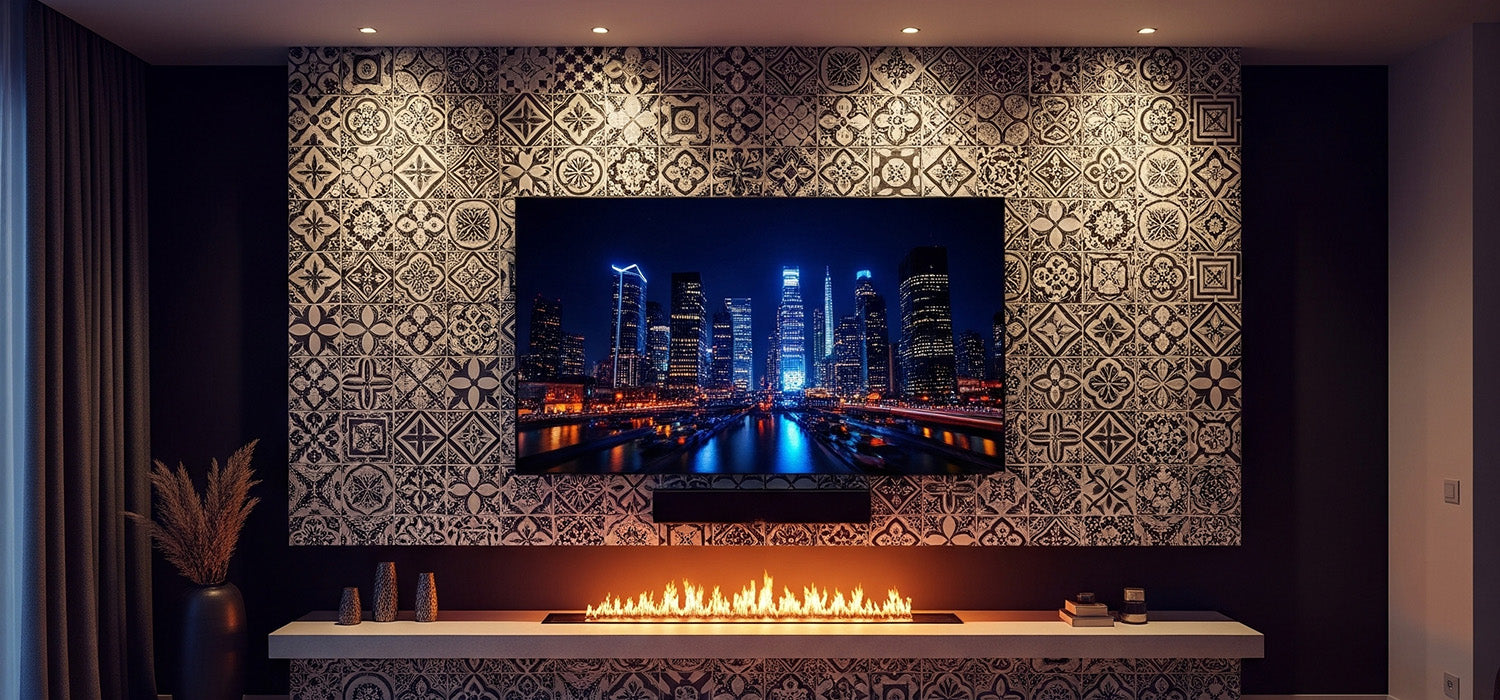
Can a Media Wall Fire Really Heat a Room? The Cosy Truth
Yes, a Media Wall Fire can absolutely warm a room—stylishly, too! These fires blend sleek looks with solid heat output. But how do they stack up against radiators? And what affects their performance? Let’s dive in (without freezing) and uncover the warm truth behind the flames.
Understanding Heat Output: Electric vs. Gas Media Wall Fires
So, you’ve seen a media wall fire online, or maybe a mate has one in their living room, flickering away beneath a massive telly. It looks amazing, right? But here’s the big question—does it actually heat the room, or is it all show and no glow?
Let’s break it down by type: electric vs gas.
Electric Fireplaces: Ambiance with a Touch of Warmth
Electric media wall fires are like that stylish coat that’s better for autumn than deep winter. They look great and give off a nice bit of heat, but they’re not going to replace your entire heating system. Think of them as atmosphere enhancers with benefits.
Most electric models kick out between 1.5kW and 2.5kW. That’s enough to take the edge off in a bedroom or lounge, especially in well-insulated homes.
They’re brilliant if you want to warm a specific corner or zone—say, where you watch TV or read your book. And let’s face it, they’re so easy to install, often just plug-and-play.
Typical Heat Output (in BTUs or Watts)
To put numbers to the warmth: 1.5kW to 2.5kW equals about 5,000 to 8,500 BTUs. Not bad for a wall-mounted fireplace. But remember, that’s supplemental heat—not central heating replacement territory.
Best for Supplemental or Zone Heating
Electric fires are spot-heaters. They're ideal for cosying up a part of the room you're actually in, like a reading nook or sofa area.
Got underfloor heating or radiators doing the heavy lifting? Perfect—add a media wall fire for targeted warmth and major vibes.
Gas Fireplaces: A More Powerful Heating Option
Now, gas media wall fires—these are the big hitters. They bring both heat and head-turning visuals to the party.
They’re a better choice if you want the fire to really warm up a room, not just look the part.
Comparing Heat Output to Electric Models
While electric fires max out at 2.5kW, gas units can easily reach 4kW to 7kW. That’s serious warmth. Think of it like switching from a hairdryer to a patio heater.
If you’ve got a larger lounge, an open-plan kitchen-diner, or high ceilings, gas might be the better bet.
Can a Gas Media Fire Replace Central Heating?
Technically? Yes. In a modern, insulated home, a 6 or 7kW gas media wall fire can absolutely keep a room toasty. But like all things heating, it comes down to how well your space holds onto heat.
It's not just about blasting warm air—it’s about keeping it there.
Factors That Affect a Media Wall Fire's Heating Ability
Even the best fire won’t do much good if your room’s bleeding heat. Here’s what can affect your media wall fire’s performance.
Room Size and Layout (Open-Plan vs. Enclosed)
A small, enclosed lounge? Your fire will work like a charm.
But if you’ve got an open-plan living space stretching into the kitchen, dining area, and hallway, that warmth will disperse quickly. Open spaces look fab but can be heating nightmares.
You might need to up the kilowatts—or add a backup heat source.
Insulation and Drafts in Your Home
You wouldn’t wear a vest in winter and expect to stay warm, right? Same goes for your house.
If your walls are poorly insulated or your windows are letting in icy draughts, even the best media wall fire will struggle. Insulation makes or breaks heating performance.
Draft-proofing your doors and sealing windows can make a world of difference.
Ceiling Height and Overall Room Volume
Heat rises. That beautiful vaulted ceiling? Lovely to look at. Terrible for retaining warmth.
The higher the ceiling, the harder your fire has to work. In these cases, it's often wise to look for a fire with a fan or consider pairing it with another heat source.
Maximising the Warmth from Your Media Wall Fire
Want to squeeze every last bit of heat from your fire? Here’s how to do it properly.
Proper Installation and Ventilation
Let’s start with the basics: installation matters. A poorly fitted media wall fire won’t perform as it should. And in the case of gas models, ventilation is crucial—not just for warmth, but for safety.
Always hire a professional fitter. A neat job helps keep heat directed where you want it—in the room.
Using a Fan to Distribute Heat
Some fires come with built-in fans that help push the warmth into your space. Without it, the heat might just linger near the unit—or rise straight up.
For large rooms, consider adding a discreet circulation fan to spread the heat evenly. Not the prettiest fix, but highly effective.
Combining with Other Heating Sources
Media wall fires don’t have to do it all alone.
They work brilliantly as part of a mixed heating strategy. Think underfloor heating for background warmth, with your fire giving you the direct, instant heat boost.
Smart thermostats and zone heating setups can also help tailor warmth precisely where you need it.
Bioethanol vs. Electric: Which Is a Better Choice for You?
Let’s not forget the third contender: the bioethanol fire. These beauties burn real flames using alcohol-based fuel. No plug. No gas line. No chimney.
But are they warm enough?
They typically produce between 1.5kW and 3kW—on par with electric models. So again, best used for spot heating, not replacing your central system.
If you love a real flame but want flexibility (and no soot or smoke), they’re a good shout. Just remember you’ll be refilling the fuel manually.
Electric fires, on the other hand, are low-maintenance and often come with remotes, timers and even app control.
Final Thoughts: Is a Media Wall Fire Enough?
So—are media wall fires warm enough to heat a room?
Yes, absolutely—if you pick the right type and match it to your space. Electric fires are fantastic for smaller rooms and added ambiance. Gas models pack the heat and can stand in as a primary heat source. Bioethanol fires offer real flame style with gentle warmth.
But don’t just think about power. Consider your room layout, insulation, ceiling height and whether you’ll combine your media wall fire with other heating.
Choose wisely, install properly, and your media wall fire won’t just be a stunning centrepiece—it’ll keep your space warm and welcoming too.
Other content we think you'll love
- Bioethanol vs Electric Fires: Which Fireplace Fits Your Home?
- How to Build the Perfect Media Wall Around Your Fireplace
- How to Build a Media Wall Around a Chimney Breast
- How to Build a Stylish Media Wall Around a Log Burner
- Bioethanol vs Electric: Which Media Wall Fire Is Best for You?
- Transform Your Chimney Breast: Create a Stunning Media Wall

